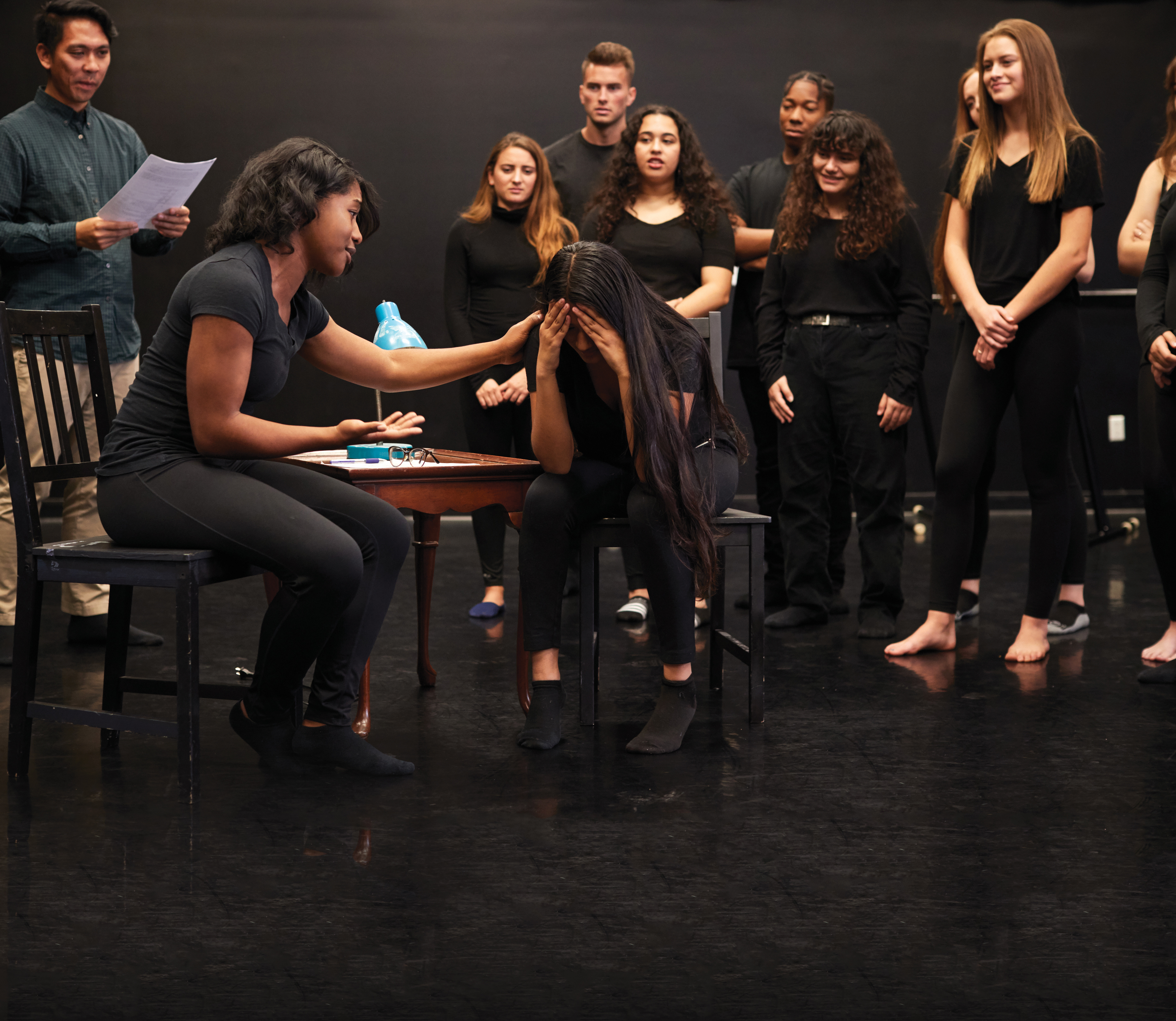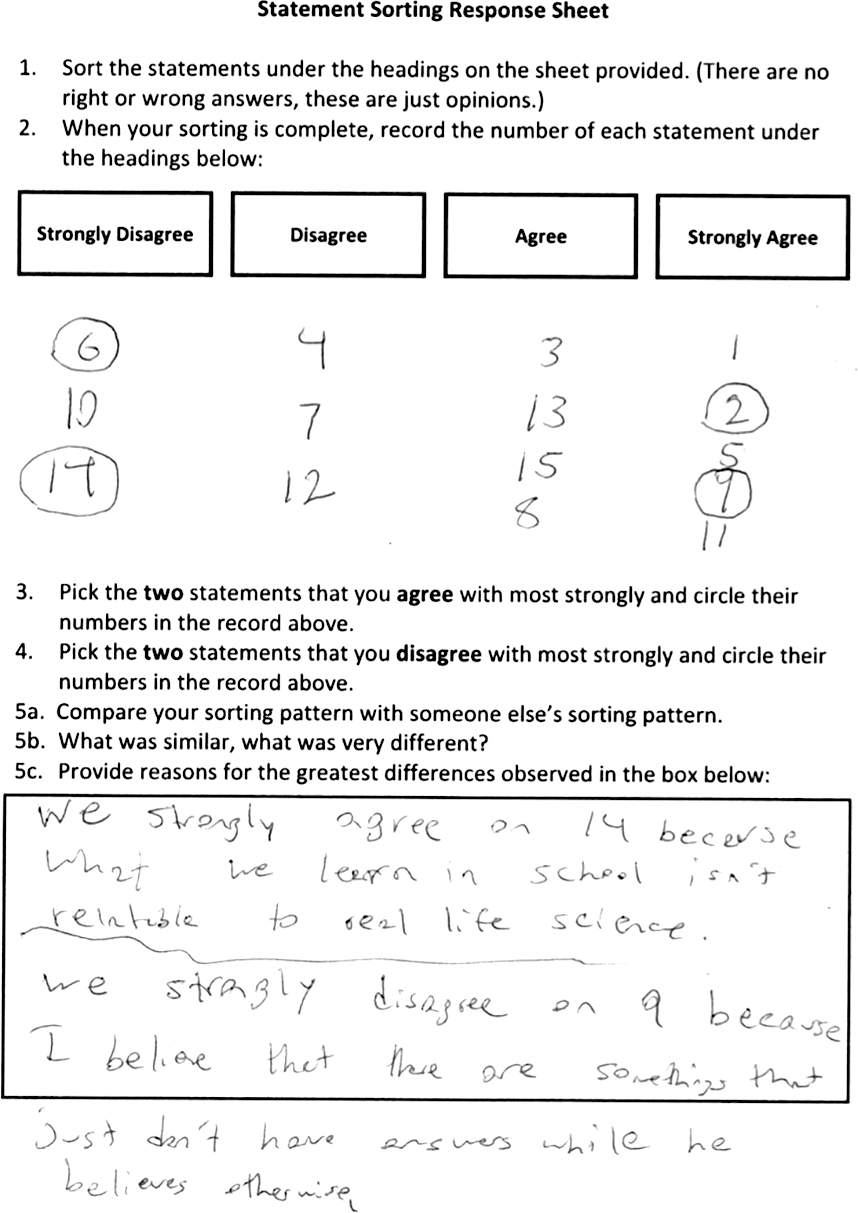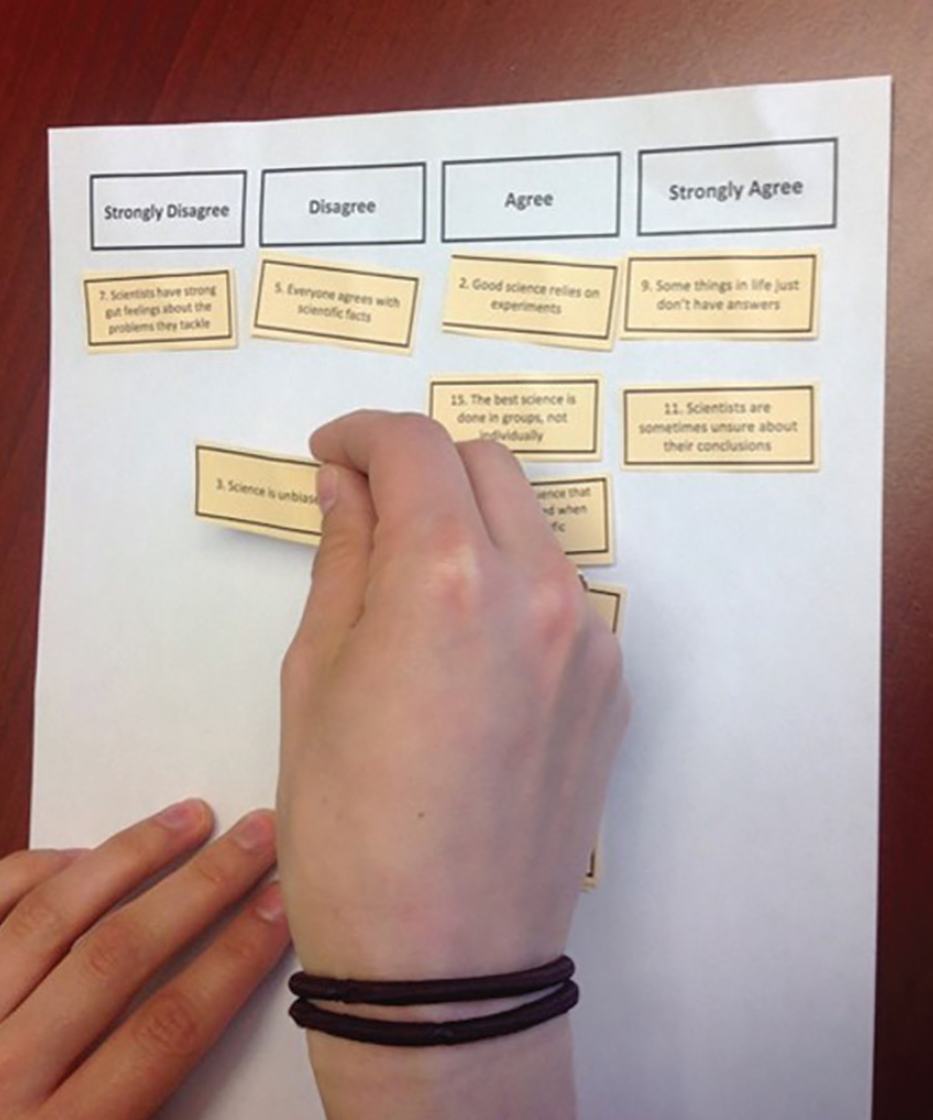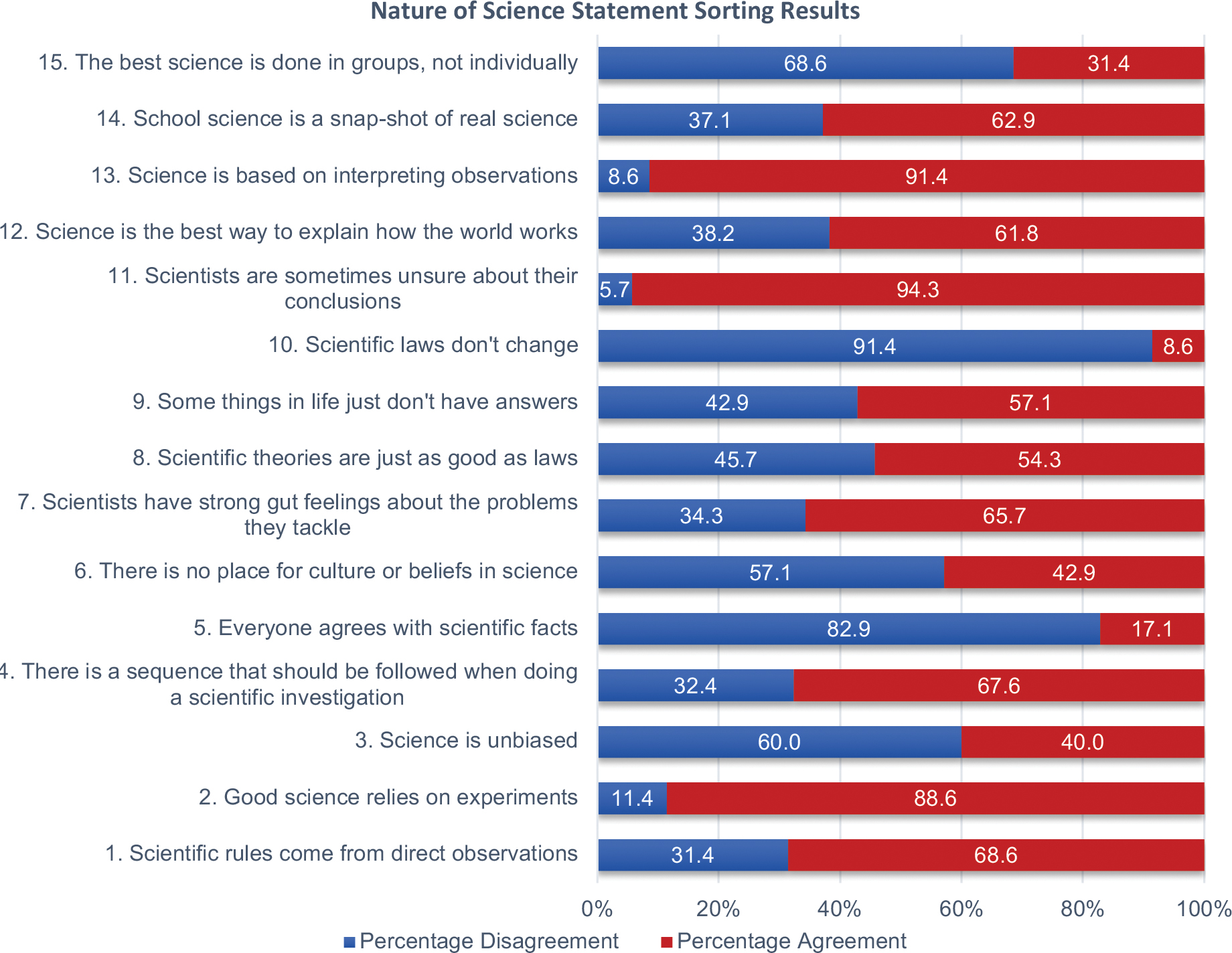feature
Using Drama to Uncover and Expand Student Understandings of the Nature of Science
The Science Teacher—November/December 2020 (Volume 88, Issue 2)
By Lydia E Carol-Ann Burke, Alison McAvella and Anne Wessels

Science education research demonstrates that although children engage enthusiastically with science at the elementary level, this interest is not upheld in the secondary school setting (Anderhag et al. 2016; Lyons 2006). This means that high school science teachers face a particular challenge in re-engaging disaffected students. Gaining a better understanding of how science is embedded and embodied in everyday student experiences—both in and out of the classroom— can support teachers in devising science pedagogy that is responsive and relevant to students (Medin and Bang 2014) while helping students be more conscious of science in their own lives. This article offers useful methods to explore ways that students relate to science while presenting methods for expanding students’ prior understandings.
Researchers have demonstrated a correlation between personal value, enjoyment and interest, and sustained engagement in science (Ainley and Ainley 2011). This article presents pedagogical strategies that use drama and discussion to explore students’ everyday encounters with science by engaging the body and emotion. Drama-based discussions in science classrooms can be far-ranging as students express feelings and describe experiences in ways not common in science education. Teachers should be patient as the students express themselves, being very attentive to the students’ comments, repeating and seeking amplifications and clarifications until students are satisfied that they have clearly communicated their ideas.
We outline four teaching strategies, each of which is 30 minutes to 1 hour long. These strategies can be used as diagnostic tools to support the design of future learning opportunities that take into account students’ current understandings. Having used the various approaches in different educational contexts at different times, we tested all four strategies with a group of students from a private school and with a group of students from a low-income community club. The approaches were equally effective in each case. We illustrate how these activities can be used independently or in combination to broaden and expand student understandings. The strategies serve as formative assessment, providing the teacher with in-process feedback on student understandings regarding the nature of science. Although we recommend that teachers use the strategies early in the science course, we stress the importance of revisiting emerging ideas so that teachers continue to develop curriculum that considers students’ commonly held beliefs and emerging understandings. If teachers are unfamiliar or somewhat uncomfortable with using drama in science classrooms, we suggest they start with a single strategy (i.e., Strategy I) and build up their repertoire over time as their confidence and expertise grows.
Strategy 1: Nature of Science statement sorting task
This activity can serve as a starting point for each of the subsequent drama strategies. The Nature of Science Statement Sorting Task engages students in conversations about science that are intended to reveal their opinions and attitudes. In this task, students receive 15 statements about science on separate pieces of paper (see Table 1) and a statement sorting response sheet (see Figure 1). The statements are based on the Views of the Nature of Science (VNOS) questionnaires developed by Chen (2006) and Lederman, Abd-El-Khalick, Bell, and Schwartz (2002). Working individually, students sort the statements into one of four categories: strongly agree, agree, disagree, or strongly disagree (see Figure 2). There is no neutral sorting category; this encourages students to carefully decide whether their views are more aligned with the agree or disagree category. Students record their sorting decisions on the statement sorting response sheet (Figure 1). Students then select two statements representing their strongest points of agreement and two statements representing their strongest disagreement; they record these selections on the statement sorting response sheet (stages 1 to 4 in Figure 1).

Sample Statement Sorting Response Sheet.
| Table 1. Classification of statements according to Nature of Science characteristics. | ||||||||||||||||
|---|---|---|---|---|---|---|---|---|---|---|---|---|---|---|---|---|
|
Following the individual sorting exercise, students share their decisions with a partner or in a small group (stages 5 and 6 in Figure 1), focusing on the statements that were most difficult to sort. In the open box on the response sheet (stage 7 in Figure 1), students record points raised during the small-group discussion. A full-class discussion can follow in which students articulate their stance on the statements. The teacher should allow students to speak about their perspectives without providing any evaluative feedback; at this stage, teachers can begin to gauge the trends in students’ interpretations and ideas. Follow ing the whole-group discussion, the teacher collects response sheets for review. At this stage teachers may see trends in the information collected and gain further insight into which statements generated the strongest emotions.

Statement sorting process.
Reflect and extend
The next step in this strategy happens in a later class, after the teacher has converted the data recorded on the record sheets into a bar chart (see Figure 3) or a simple breakdown of percentages. Students review the whole group’s record of agreement and disagreement with the nature of science statements. The teacher then facilitates a discussion in which students can share their understandings, ask questions of each other, and provide examples from personal experience. The teacher can offer prompts to promote breadth and depth of discussion, such as: “Why do you think a person might feel this way?” or “Why might others agree or disagree with the way you see science?” The teacher can share common interpretations of the nature of science and choose to assign a summative piece of reflective writing to gauge how student understandings have developed.

Sample percentage agreement and disagreement with Nature of Science statements.
Strategy 2 - personification of science drama activity
During this drama activity, students explore two questions: (1) What is the relationship between science and the science student? and (2) If science were a person, how would science and the student interact? Student pairs create ‘freeze-frame’ depictions (tableaux) to represent the relationship between Science and Student. This strategy of striking and holding a pose is similar to the recent mannequin challenge trend and could be explained and set up in the same way.
Students have 10 minutes to choose the kind of relationship they would like to depict between Science and Student in their tableau. To gain insights into students’ personal perspectives, the teacher circulates as students plan/rehearse and asks questions such as, “Can you explain why a person would feel that way?” or “How did you come up with this?” At the end of the planning period, the whole class gathers to share the various tableaux. Following each pair’s presentation, the teacher and peers discuss their various interpretations of the tableau and offer validations or counter-stories based on their own experiences. The teacher guides the discussion to examine the reasons why people may feel the way they do about science and to explore what kinds of depictions are missing, generating possible explanations for these omissions.
Reflect and extend
To illustrate how the post-tableau discussions can be used by teachers to inform pedagogy, we share an example from our work. A pair of students depicted Science sitting on a dejected Student, conveying how overwhelming science can be and how helpless a student may feel when trying to resist the pressure of science. This tableau stimulated deeper conversation about the students’ relationships with science. The group was asked, “Does it feel as if science is that big or unapproachable that your relationship with it wouldn’t make a difference to it? Do young people have any influence on what science is at all?” Students then explained that they will influence science in the future as they pursue careers in science, but they felt they had little agency as they interact with science in the present. A teacher may use this information to challenge students to think of people who use or influence the direction of science and scientific research. Contemporary examples may include the work of Swedish teenager Greta Thunberg whose activism challenges the way people view and value science.
These kinds of discussion extensions broaden the ways that students think about science by providing local and global counter-stories that stretch students’ perspectives on science. Some of the dynamics we have seen depicted include: Science as mentor with Student as appreciative mentee; Science and Student as close friends; Science as indifferent, despite Student’s attempts to gain attention; Science as a societal leader with Student as loyal follower; Science as instructor with Student as eager pupil; Science as creative influence with Student being inspired. As with other strategies, the teacher can incorporate a culminating piece of reflective writing that will allow students to express thoughts and concerns about science; teachers can use the writing to gauge idea development as the course progresses.
Strategy 3 - viewing or enacting a science- themed performance
Various drama/theatre approaches have been described in science education research (Dorion 2009; Everett 2015). Some teachers regularly use role-play to illustrate and/or reinforce a scientific concept where students are asked to embody and enact scientific phenomena as metaphors. For example, students behaving as atoms link arms to form the shape of a water molecule, then move around a confined space in ways that would demonstrate the breaking and forming of hydrogen bonds in the liquid state. Another common use of dramatization is seen when students view or enact historical dramas such as the much-acclaimed play Copenhagen, by Michael Frayn (2000), which recounts the meeting of physicists Heisenberg and Bohr during the Second World War. Historically themed plays often aim to explore the messiness of socioscientific issues that continue to have impact in contemporary contexts.
We offer an example of a third genre of science-themed performance and the use of in-class post-performance discussion to build understandings of the nature of science. Students visited a local theater to view a science-themed play, Sequence, by Canadian playwright Arun Lakra (2014). This play was selected because it allowed students to explore the nature of science from multiple angles, addressing themes of genetics, scientific certainty, luck, faith, and mathematical probability, communicated through character narratives. A formal post-performance discussion about the play’s themes was conducted within the theater where actors and the director fielded questions from the audience about the play. We recognize that this strategy depends on the local availability of science-themed plays and school/student resources to facilitate theater attendance. Alternatives include collaborating with the school drama teacher to explore options for science-themed drama activities or school- based production of a play. Any play that highlights a scientific concept (in our case, genetics)—combined with a social or cultural storyline that introduces some form of complexity or mor- al/ethical problem-solving—would be suitable. By their very nature, most science-themed plays fit these criteria, but teachers may find the Science Plays (n.d.) and Curtain Up (2016) website resources helpful when selecting a play, based on reviews and additional guidelines provided.
Reflect and extend
Back at school, the in-class post-performance discussions can present students with opportunities to view aspects of the nature of science from the perspectives of characters in the play. Questions to guide discussion are listed below.
- Did anyone in the play illustrate adherence to a way of knowing outside of science? What evidence did you have for that?
- Give examples to suggest who demonstrated the most scientific approach to life in the play?
- In what ways did the person/people identified above indicate that science is tentative?
- What evidence of creativity in science did you see in the play?
- How did the social context influence the science being explored in the play?
- Evaluate the rigor of the scientific methods being illustrated in the play.
These questions could also be explored as students’ written reflections that would serve as formative assessment to help shape the teachers’ future instruction.
Strategy 4 - creating scenes based on student-selected scientific issues
This drama strategy focuses on students creating scenes that represent extracts from a larger storyline. First, the class collectively generates a list of important contemporary scientific issues—these issues can be local or global and can be general or specific to the topic of study. After creating the list, students as a group prioritize the issues (e.g., using a dotmocracy survey or other voting strategy); the top-ranking issues are then distributed as topics for small group work.
In smaller groups, students then develop a short scene based on the issue assigned; the goal is to work toward an “inciting incident”—an event that would propel the main character into the central problem of the story in a dramatic or life-changing way. For example, in the play Sequence, two parallel storylines eventually converge but each represents its own mode of progression toward an inciting incident. In one storyline, a visually impaired professor is working late into the evening to continue her work of finding a cure for the disease that is causing her own blindness when she receives a visit from one of her students who has defied all odds by getting all 150 multiple choice questions wrong in his final examination. In a second storyline, a man dubbed the Luckiest Man Alive has won a fortune by correctly guessing the outcome of the Super Bowl coin toss for 20 years in a row; he is prepared to risk it all in his 21st guess when he is interrupted by a woman who claims that she has unlocked the mathematics behind his coin toss guesses. In each storyline, the exchange at the point of confrontation is the incident that draws the viewer into the story and marks the point when things get more complicated for the main character.
In this strategy, students do not generate an entire play, they create their own ‘take’ on the given issue by loosely scripting and then acting out their chosen storyline up to and including the inciting incident. Students have 20 to 30 minutes to rehearse in their groups before presenting their scenes to the class. As with the other strategies, students’ written reflections could be gathered by the teacher to support future lesson planning.
Reflect and extend
Teachers can use the students’ scenes to guide conversations that illustrate or challenge any of the nature of science characteristics listed in Table 1, using the guiding questions provided in Strategy 3. For example, one group presented a scene associated with animal testing which allowed us to explore the social and cultural contexts that contribute to our beliefs about the status of animals in society, as well as empirical evidence that might support or discredit the use of animals in testing for human benefit. Although we found it interesting to explore issues in society that the students considered important, there is no reason why themes for scene development could not be selected based on the particular topic being studied in class.
Conclusion
The use of transdisciplinary approaches in science learning can support student engagement by addressing the nature of science in novel, embodied, and emotionally connected ways. Given that student attitudes toward science can be influenced by emotions associated with all aspects of their various life experiences, it is important that teachers have tools available to engage the affective learning domain through practices such as drama. The strategies outlined in this paper are summarized in Table 2.
| Table 2. Summary of activities outlined in this paper. | |||||||||||||||
|---|---|---|---|---|---|---|---|---|---|---|---|---|---|---|---|
|
We also recommend that this learning be consolidated, deepened, and reconsidered by regularly and intentionally revisiting the nature of science throughout the school year. By referring back to the activities, discussions, and written reflections outlined above, students can reflect on their changing and developing understandings. The implementation of informed and responsively constructed lessons can broaden students’ perceptions of the nature of science and equip teachers with tools to support students in making meaningful connections with, and reflections on, the relevance of science in their everyday experiences.
Lydia E Carol-Ann Burke (carolann.burke@utoronto.ca) is an assistant professor of science education at the Ontario Institute for Studies in Education (OISE), University of Toronto in Ontario, Canada, Alison McAvella is a secondary science and mathematics teacher with the Waterloo Region District School Board in Ontario, Canada, and Anne Wessels is a sessional lecturer in drama education at the Ontario Institute for Studies in Education (OISE), University of Toronto in Ontario, Canada.
Interdisciplinary Teaching Strategies High School


